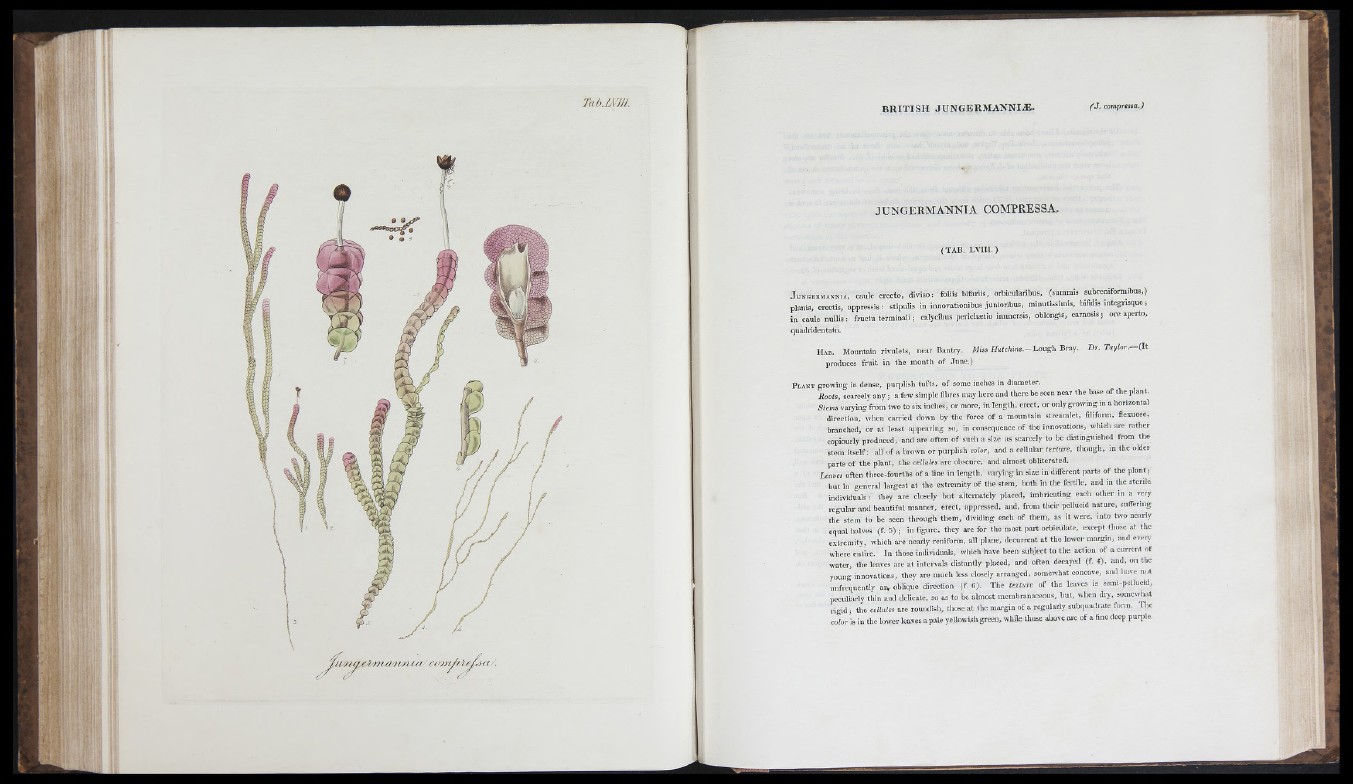
' i :
f i ’i
:|æ -
M 'I
a;«!' .
• f
’A
A ,
h.
I # .
k
^îii
ri
-1 il
fi
'î
r i .
.’ i i l
ri'i
• |
J
( 7 7
JU N G E RM A N N IA COMPRESSA,
(TA B. L V I I I .)
J „ H 0..MAXX.*, oaolc ere c to, d iv ise : foiiis bifariis, orbicularibus, (sumuris subreniforruibus,)
planis, erectis, appre ssis: stipulis in innovationibus junioribus, minutUsimis, bifidis in teg n sq u e ;
in caule nullls : fruc tu terminali ; calycibus perichætio immersis, oblongis, earnosis ; ore aperto,
quadridentato.
H ab. Mountain riv u le ts, ne a r Bantry. Miss Hutchins.— 'Lough Bray. Dr. Taylor.— {It
produces fro it in th e m o n th o f June .)
P l a n t growing in dense, purplish tu fts , o f some inches in diameter.
Roots, scarcely any ; a few simple fibres may h ere and there be seen ne a r th e base o f th e p lant.
Stems varying from two to six inches, or m ore, in len g th , erect, or only growing in a horizontal
direction, when carried down by th e force o f a mounta in streamlet, filiform, flexuose,
branched, o r a t le a st appearing so, in consequence o f the innovations, which are ra th e r
copiously produced, and are often o f such a size as scarcely to be distinguished from the
stem itse lf: uli o f a brown or purplish color, and a cellular te itn re , th o u g h , in th e older
p a rts o f th e p lant, th e cellules are obscure, and almost obliterated.
Leaves often thre e -fourths of a line in le n g th , varying in size in different parts o f th e p la n t;
b u t in general la rge st a t the extremity of the stem, both in th e fertile, and in the sterile
individuals ; they are closely b u t alternately placed, imbricating each other in a very
r e g u la r and beautiful manner, erect, appressed, and, from th e ir pellucid n a tu re , suffering
the stem to be seen th ro u g h th em , dividing each o f th em , as it were, into two nearly
equal halves (f. 5) j in figure, they are for the most pa rt orbiculate, except those at the
extremity, which a re nearly reniform, all plane, decurrent a t th e lower margin, and every
where entire. In those individuals, which have been subject to th e action o f a current of
wa te r, the leaves are a t intervals distantly placed, and often decayed (f. 4 ) , and, on the
young innovations, they are much less closely a rranged, somewhat concave, and have n ot
unfrequently an, oblique direction (f. 6). T h e texture o f th e leaves is semi-pellucid,
l>eculiarly th in and delicate, so as to be almost membranaceous, b ut, when dry, somewhat
rigid ; tlie cellules are roundish, those a t th e m argin of a regularly subquadrate form. The
color is in the lower leaves a pale yeUowish g re en, while those above are o f a fine deep purple.